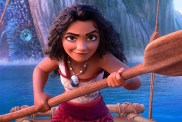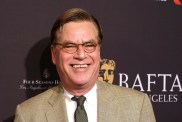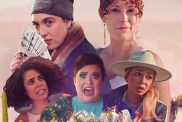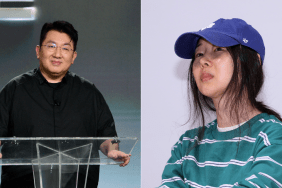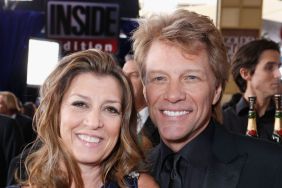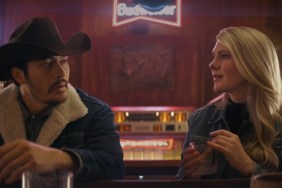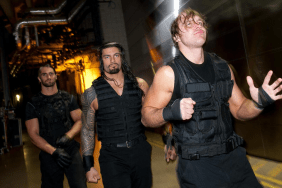Q: The Indiana Jones series has always stood in as the perfect example of the action/adventure blockbuster. How do you think the films’ imagery now holds up against todays standards?
Dennis Muren: I dont know if I’d want to compare images then and now, because I think the old ones hold up very well. Having been there and, having lived through it, theres just something in the reality of it that usurps any technical problems we might have had in those days. It gives it a very handmade feel. I think the movies hold up extremely well, not that newer ones arent also good. But the smell and the feel of all the effects material, I think, fits with the rest of the movies. If these movies were all made in studios, that would be one thing. Those real locations and the reality of everything… I also think really helps that the effects are all real things also.
Q: The visual effects in the films have had just about as strong an impact in film history as Harrison Ford embodying the role. Can you speak to that?
Muren: I guess so, but, man, Harrison is the movie. We were supplementary to all that, but they’re important because what George and Steven always wanted was to be able to experience a hyper-adventure that this guy is wild and crazy enough to get into. The effects were there to sort of supplement that and to go beyond whatever going on — probably in the “James Bond” movies, which were pretty much rooted in reality in their times. You can get out of reality and have a real thrill ride adventure. That’s what they were going for in this film and that’s where the FX needed to come in. To do things that just couldn’t be done for real.
Q: These films changed the audio landscape of film. Can you comment on what it was like to embark on this historical journey?
Ben Burtt: For the “Indiana Jones” movies, I started off my career with “Star Wars” and, of course, in “Star Wars,” the sound was being attached to give credibility to a highly imaginative universe of characters, places and things. Then along came Indy and, of course, the action adventure genre was my favorite. The films that this series pays homage to are the films I loved growing up: the westerns and the adventure movies, the “Tarzan” movies, “Gunga Din.” That sort of thing. I was so excited to work on it and I knew that the sound effects in those classic movies — as they are today — are added after the fact. They’re not the sounds that are recorded during filming because you want control of the sounds later. Mostly there isn’t appropriate sound on the set that is right for the final movie. My job and the job of the team that I work with is to create all of that and add it in. I could have gone to a library at any studio and gotten face punches, fire explosions and trucks. These things had been in movies many times before and they were good recordings. What I wanted to do was to specifically not do that, but instead to build our own new, customized “Indiana Jones” library that would have it’s own signature. Conceptually, it would be based on my favorite sounds from the classic movies of the past. I would study the gunshots in all the movies that I loved and I’d say, “Well, how did they do it? How can I make something that is better, but pays [homage]?” It’s a legacy and it owes its origins to what’s been movie language up to that point because so many things about the “Indiana Jones” series were new visions of things that had existed in movies before, but now put together all under the adventures of one character. So, we set out to record everything over again: new fires and new explosions, new body falls, new truck skids, new skids, whatever it might be. Then, on top of that, there’s a level of reality. There was always the mystical and supernatural elements of these films — the Crystal Skull, the Sankara Stones, the Ark of the Covenant — in order to portray the sounds for those objects, there were little supernatural things that were maybe a little bit more like “Star Wars” in the sense that they related to things that were unfamiliar. Alien things that were new. We wanted to give those sounds an expressive voice. Give those objects an expressive voice as well. That was also my department: to try and come up with sounds for all of that. There was both the science fiction element and, I would call it, the fantasy element to the sounds in addition to the reality based elements.
Q: Looking back at these films must evoke certain memories for you both that are probably very different than the memories that audiences might have. Dennis, are there some favorite moments that you can share with us about?
Muren: Well, “Temple of Doom” was really, really memorable. We had the big mine chase in that, which was very difficult. Shots that go on and on going through this tunnel. Of course, they couldn’t do it for real. They had a nice tunnel that they could get some shots with, but not the vistas or the length of travel that they needed to carry the dramatic effect. In order to build these long sets, they used miniature sets, but the size was dependent on the size of the camera of all things. The camera had to go through the tunnel. I came up with idea of using just a Nikon still camera instead of shooting with one of the bigger movie cameras. Just use a still camera to shoot still frame after frame after frame. These shots only ran for four or five seconds anyway. We could get that on one load on a Nikon camera. That meant that all the sets could be smaller. They only needed to be a hundred feet long instead of three hundred feet long and we didn’t have room in San Rafael to build anything very long anyway. It just saved a heck of a lot of money, which everyone was happy about because these films, no matter how they appear, were always done on very, very tight budgets. We always had to really work within that and then the work came out really great in that sequence, too. The cave walls are aluminum foil. Heavy aluminum foil, painted. It’s all done with a sort of soft motion or go motions ith frame-at-a-time motion motors. It was really pretty neat. Then the other thing for my experience was that I got to act in one little sequence in “Raiders of the Lost Ark.” When Harrison goes on the airplane and there’s the spy who’s in front reading a “Life Magazine,” that’s me in there. I’ll tell you, that’s the weirdest experience, going from behind the scenes to being in front of the camera with Spielberg looking at you here and Harrison over there. It’s like, “What the heck am I doing here?” We shot it over in Richmond here where the plane was. The plane actually couldn’t fly but, fortunately, it was nearby and we went over there and shot all those scenes in one morning. That was a pretty darn neat experience. I thought it would lead to bigger parts, but
(laughs)
Q: I heard you gave Harrison a run for his money.
Muren: You should’ve seen what they cut out!

Q: Ben, are there any particular memories that you have of any moment in the film?
Burtt: Well, since we go out on expeditions to gather the sound or to invent special props, there’s always a story with every sound. Dennis mentions the mine car chase. We wanted the sound of these cars clattering down the tracks and squealing around corners. We thought, “Perhaps, is there any place we could go and record something full size like that?” And we ended up making arrangements to go to Disneyland at night when the park was closed and ride all of the roller coasters to record them. We would go into Space Mountain, turn all the lights on and turn the music off and ride in the cars or stand alongside the track and get the squealing around the corners. Gary Summers and I were working together on that, gathering all these sounds. We had a wonderful, all night Disneyland experience. Big Thunder, Space Mountain, The Matterhorn. All of them completely out of context with the lights on so that you could see all the behind scenes stuff. That was fun. Right here on the ranch, at the time of “Raiders of the Lost Ark,” this building [we’re in now] did not exist. There were no buildings on the ranch. It was just an empty property and Gary and I used to come out here every afternoon. It was quiet and there weren’t birds or frogs to interfere with recordings. We would stage sound effects events here at the ranch that we needed for “Raiders.” When you walk out the front door, you’ll notice up on the hill there a big rock outcropping. We spent a day laboriously carrying rocks and gravel and everything we could find to the top of that rock outcropping and then we shoved it down the rock face and recorded all the tumbling rocks and dust and grit. We have used — or derived from — that recording just about every rock effect that you hear in these movies, when things are collapsing or a temple falls apart. You slow the sound down. Right here where this theater is today, just take it away. We had a shooting range. There was a gully here, right about where you’re allotting and some old car was down in it. We brought out some of the explosive guys from ILM and we blew things up here for a while to get a lot of explosions. We found that this canyon right here where the tech building is today had wonderful acoustics. The sound would slap back and forth. We did all the gunshots that you hear for Indy’s gun. We did it with much higher powered rifles. Of course, everything in “Indiana Jones” is exaggerated. His pistol isn’t just a little .38 calibre pop. We would’ve used a Howitzer if we could’ve brought one in here. We did some gunshot recordings and slowed them down and beefed them up a lot to get these sounds. We did all the ricochets here. There’s a lot of stories about trying to bounce bullets around. In fact, we got in trouble here because we had some machine guns and we didn’t tell anyone what we were doing. We were out here and we got a little carried away just shooting things and shooting the ground and other targets with live ammunition. We had some people from L.A. come up, Stembridge Gun Rentals, so we had a permit, but we didn’t tell anyone. Finally, a bunch of headlights come down the road. We were doing this in the evening and people were wanting to know if we were terrorists or something and they didn’t understand. The neighbors were complaining, I guess. In any event, this was our recording studio, this whole outdoor area. So much of the “Raiders” material was done right here. We brought a truck up here and I would run and throw myself against the hood of the truck for Indy banging onto the hood. Gary Summers did the whip cracks on road, right here next to where this building is today and we could get the echo and the trees and all of that. So, this is really pleasant memories about deriving sounds. There were hundreds of things that we had to gather just like that. It wasn’t just a simple matter of getting the right technical recording. It’s all about finding the right performance and the right acoustic location. We tend to do things outside because there’d be enough echo, especially in the trees that, when you put that sound in the movie, it would really fit into the context of the location, in the jungle or something of that sort.
Q: What was the biggest challenge for the series’ visual effects?
Muren: It was having to cut in, hopefully perfectly, with no sign of an effect. Getting it totally real and not breaking the reality of it. That gets harder and harder to do that with every film that we did. I’d say on the artistic side, it’s the attention to the detail, the reality, the feel of a Steven Spielberg directed scene. Even though he didn’t direct the effects scenes, he certainly approved everything. That and probably some of the motion stuff that we did with the mine chase cars moving so they didn’t look like they were stop motion or very much like a miniature, hopefully. I wouldn’t say that we invented a lot of new gear for it. It was more being able to sort of use it in a way that was more pristine and more in the style of Steven actually out there directing the stuff for real. That’s really hard to do or else those shots could just pop and look like they were done by a second unit or something like that.
Q: One of the most famous sound effects in the series is the punches. How did you make those?
Burtt: As big as possible. The question is where do the punches come from. Well, there’s one part that I’m not going to tell you because I have to protect a few things so I have future work! There’s always punches to be needed in the movies. Of course there’s body punches and there’s face punches. They’re not so simple to do because an actual face punch, if you’ve ever had one or delivered one, is not very loud. It’s usually the person going, “Ugh!” or “Ouch!” or whatever. But movies have a tradition of something enormous, going all the way back to the first punches in movies in the early 1930’s. They started out using clapboards and things to make a slapping sound. A punching sound. What we did was right on the road here. We had a setup. We got a lot of baseball gloves, like catcher’s mitts and leather jackets and some football equipment. If you took a baseball bat and threw a catcher’s mitt into the air and then hit it with the baseball bat as hard as you could, you would get a good thwack. We took pumpkins and, if you took one of my favorites, a croquet ball, and you put it in a sock, you got a sort of a nunchuck weapon, You beat the pumpkin to death and, every so often, one of those hits — one out of the five or so — is a really good, meaty, kind of a choppy sound. A library was built up of those kinds of things and used for a body blow or a kick and that sort of thing. We reserved that particular set just for the Indy films because we wanted to be associated with Indiana Jones every time that he swings his fist.

Q: By the time “Crystal Skull” rolled around, did you want to embrace some of the old school methods for sound? When George Lucas told you he was building a building over your favorite recording place, were you dismayed?
Burtt: Well, it’s true. I, just for fun a few years ago, brought one of the guns back and I fired it here next to the building and recorded it to see whether it sounded the same. It didn’t because of the presence of the building and I was let down, thinking that we had lost it. But when we were initially doing those gunshots, we went all around the ranch. We probably went to thirty or forty different spots because the whole key to recording gunshots is the location where you do it. The acoustics. A good gunshot is multiple syllables and a kind of a slap and it repeats. But you also want to have some trees around so that it gives a slow decay to it. You give it character. The best gunshots always have two syllables, I think. That’s one of the big mistakes that people make today. They use one syllable gunshots. That’s my opinion.
Muren: Let me just mention one thing that Ben is talking about here. Sound effects, even though I don’t do them at all, is something like what I do in a different way. But with sound effects, it’s not like you go to “Garage Band” and just grab bullet shot. Some people would think that you’ve got your bullet shot and you’ve got your punch. They put it in the movie. They wouldn’t understand why it wouldn’t have the effect. All the time that Ben is going for this take after take, thirty times going around the ranch, is that he’s hearing something special. First of all, he’s got an idea and he’s hearing the result and saying, “Yeah, that’s good,” or “No, that’s not good enough.” You’re making a judgment all the time. That’s really kind of missing in a lot of the stuff going on today, I think. It is sort of like the “Garage Band” thing. A solution. Boom. “Just put it in, it’ll work!” But it doesn’t at all.
Burtt: That was a hell of an answer. Thank you, Dennis, that was good. I’m going to hire you for my next interview.
Q: During the restoration process, did you guys talk about bringing new sound or altering the FX?
Muren: No. There was never any talk about changing the FX at all.
Burtt: When it came to sound, I’m an avid film historian and it’s very hard for me to change the movie in some way that really modernizes it or imposes an idea that didn’t exist at the time. What I did on “Raiders,” for instance, is some touch-ups of things, because we had to expand the use of the surround tracks because that was available to us in a way now, which it wasn’t back then. The interesting thing is, some of the sounds that were in the original monaural surround track on “Raiders,” I had the original stereo recordings of all those sounds. Fortunately, I had saved all of that and I could find it so I was able to go back and take time to match up the recordings with what was there in the original release of the movie, and put them in stereo now. I did add something to the movie, but it was the same content, now just more spatial and with dimension to it. In a few places where we added a few additional sounds, I took them all off the “Raiders” library. What I thought was a few missing little body hits in the fight scenes that we originally missed. I took them off the same tape that I had back in 1981. I wanted to make sure that what was done was still in the same fabric as what was originally there, because I didnt want it to stand out and be different. I know there have been some restorations of other films that Ive seen on Blu-ray or DVD in which theyve actually changed the sound effects. Theyve composed something brand new into an old film and that really throws me off because I immediately recognize it. I wonder why they would do such a thing. I didnt want to have anything like that but, nonetheless, additions that we made to it were because theres more space to put sound in a movie now. Theres just a bigger playback system and youve got more opportunities. We added material which was from the original library so it would be consistent. “Raiders” was obviously the first one done in the golden mixing facility in Los Angeles, before we had our own mixing operation up here. The surrounds in theaters at that time in 1981 were very problematic. You didnt know whether they would ever get played correctly, at the correct level, or get played at all. The original mix on “Raiders” was where we did the mix just left center right across the front. We didnt use the surround track and got the balance of music, effects and dialogue right and get everybodys approval: George Lucas and Steven Spielberg. Then as a separate mix after that was approved, we began to conservatively add in surround effects, the idea being that we knew the movie would work up front and thats what was going to be played at most theaters, but with more of a guarantee of it being played correctly. The surrounds worked and they would be a nice enhancement, but we didnt want to put content in the surrounds that was essential to the storytelling, because it might be lost. Thats just because we knew at that time many theaters just were not going to be able to get it right. This is before THX existed and any of the other digital revolution which helped improve theaters. Now, going back, listening to “Raiders,” we say, “Boy, we were awfully conservative! Now we can have a richer experience, so lets recreate it with the same raw material.” And thats what we did. The surround is a really basic, really redone, and puts stereo music in the surrounds instead of monaural.
Q: What is your opinion on frontal sound versus a more aggressive, immersive sound field?
Burtt: As time has gone on, we kind of predicted this first as a joke years ago. We thought everythings going to move into the surrounds. Its kind of gone that way to some extent, because we have 5.1, then 7.1, and now we have 11.1. We did “Red Tails” and then theres the Dolby Atmos process, which is now being experimented with. I like it. I like to make it a more immersive experience. Once again, its a learning curve too. One time when I first started out working in stereo, people might be distracted sometimes. Sometimes something was in the surrounds, especially if they were sitting too close to a speaker. You had to be careful not to put a lot of dialogue next to their head or something that would distract them, but as time has gone on and filmmakers continually move the experience forward, its always changing and evolving. Were at a point now where were doing a lot more all around the room, and were expecting it to be played that way in home theaters as well as theatrical. I think as long as its justifiable in terms of the content of the movie, I like that direction.
